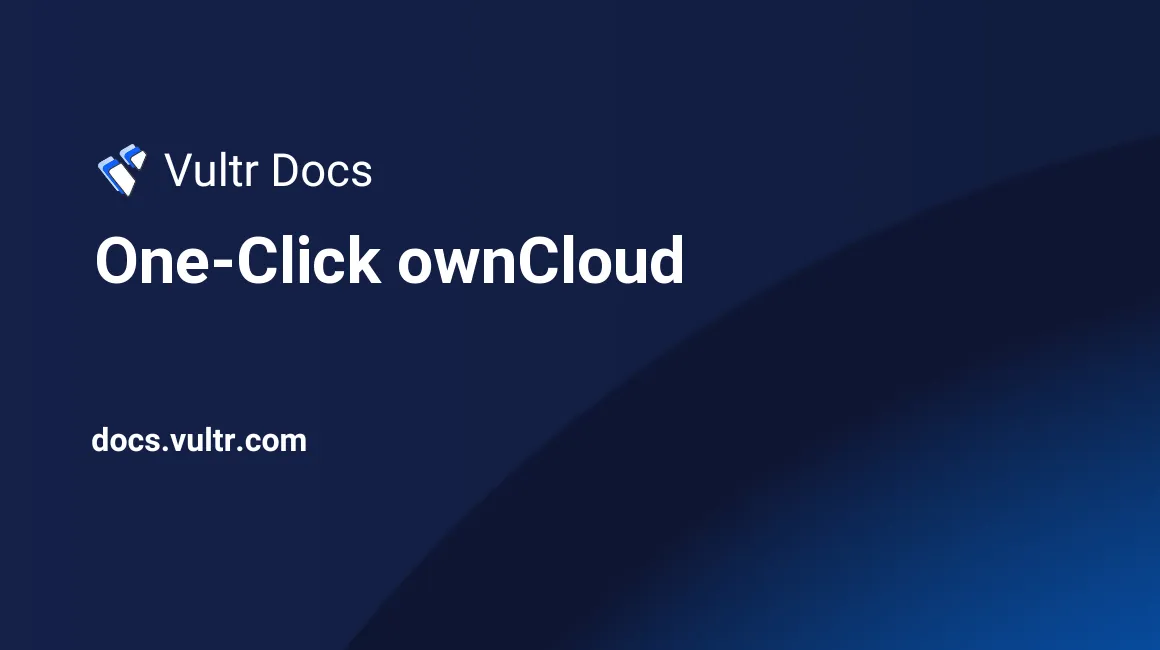
Vultr's One-Click oneCloud application is an open-source cloud-based file hosting server that allows you to access your files anywhere. It's ready to launch in about a minute. Select a server location, choose your size, and click Deploy Now. One-Click ownCloud runs on Ubuntu Server LTS.
The examples oneclick.example.com and 192.0.2.123 are used throughout this installation guide. Substitute your server's domain name or IP address.
Install SSL Certificate
This is optional, but recommended. If you skip this step and access the server by IP address, you will see a certificate warning. This warning is normal; the server is configured with a self-signed certificate. You can safely proceed past the warning. See our instructions to bypass the HTTPS warning for self-signed SSL/TLS certificates. Most ownCloud administrators will use a domain name and valid SSL certificate for their site. If you plan to use a commercial SSL certificate, see the Commercial SSL section.
To install a free Let's Encrypt SSL certificate:
Register the name and create a DNS record for the server's IP address. Consult your DNS provider for instructions, or see our guide if using Vultr's DNS.
Verify the DNS has finished propagation, and the name is visible throughout the internet before proceeding. Propagation usually happens quickly, but could take up to 48 hours in some cases.
Connect to your server, with the root login from the Server Information screen.
Request the certificate with certbot. Replace the domain name and email with your values.
# certbot certonly --nginx --redirect --agree-tos --no-eff-email -d oneclick.example.com -m admin@example.comCertbot should report success when finished.
Back up the self-signed certificates.
# mv /etc/nginx/ssl/server.crt ~ # mv /etc/nginx/ssl/server.key ~Link the Certbot certificates to Nginx.
# ln -sfv /etc/letsencrypt/live/oneclick.example.com/fullchain.pem /etc/nginx/ssl/server.crt # ln -sfv /etc/letsencrypt/live/oneclick.example.com/privkey.pem /etc/nginx/ssl/server.keyRestart the webserver.
# systemctl restart nginxEdit the trusted_domains setting in config.php.
# nano /var/www/owncloud/config/config.phpChange the IP address to your domain name. Save and exit the file.
'trusted_domains' => array ( 0 => 'oneclick.example.com', ),Navigate to your instance and verify the certificate is valid. Log in with your User login.
https://oneclick.example.com
Commercial SSL
You can use a Commercial SSL Certificate instead of the free Let's Encrypt certificate.
How to install a commercial SSL certificate
Obtain a certificate from a certificate authority for your domain.
Replace the server.crt and server.key files in /etc/nginx/ssl/ with the commercial certificate. Refer to your certificate vendor's documentation for details.
Restart the webserver.
# systemctl restart nginxEdit the trusted_domains setting in config.php.
# nano /var/www/owncloud/config/config.phpChange the IP address to your domain name. Save and exit the file.
'trusted_domains' => array ( 0 => 'oneclick.example.com', ),Navigate to your instance and verify the certificate is valid. Log in with your User login.
https://oneclick.example.com
More Information
Backup Script
The Vultr team has provided a backup script in the /root folder. You can run this file by logging in as root:
# bash backup-owncloud.shA backup of the ownCloud configuration, database, and uploaded files will be created in the /root folder. Ensure that you have enough space on your VPS to duplicate all of your files before running it.
MySQL
A MySQL database is running on your VPS. If you need to access the database directly:
Connect to the server via ssh as root.
Log into MySQL.
# mysql -u rootThe MySQL root password is saved in
/root/.my.cnf.
Cockpit Control Panel
Access your Cockpit a control panel at https://oneclick.example.com:9080. You'll find the username and password on your Server Information page.
Vultr Helper Scripts
Vultr provides helper scripts for common issues. SSH to the server as root to run these scripts.
Reset Nginx
If Nginx fails to load, you may have a typo or corruption in your configuration files. The fix-vhost.sh script will reset the Nginx configuration to default.
# /opt/vultr/fix-vhost.sh
All vhosts have been restored to their default state!Check Software Versions
For debugging purposes, our support team may ask for your software versions. Run the version.sh script.
# /opt/vultr/version.sh
OS: '18.04.4 LTS (Bionic Beaver)'
OwnCloud: '10.4.1'Older CentOS instances: Upgrading from 7.0 to 8.0
If your Vultr ownCloud app is running ownCloud 7, it is not recommended to upgrade to 8.0 with the update center, as there are known issues with the ownCloud updater. If you have already started the 8.0 update process, here are some commands that will help resolve upgrade issues.
# (login as root)
# First run this
yum -y install redis
service php-fpm restart
# After upgrade completes - if you see a blank page.
cd /var/www/owncloud
mv apps/calendar/ apps/calendar7
mv apps/contacts/ apps/contacts7
# Review the admin page for any other errors
# https://[SERVER_IP]/index.php/settings/adminAbout One-Click Apps
One-Click apps are updated regularly without notice. When launching a One-Click app, you'll receive our latest version. We do not update deployed instances, and you are responsible for keeping the instance up-to-date. If you design an infrastructure based on One-Click apps and need to ensure the same app version in the future, take a snapshot of the initial deployment and create new instances from the snapshot.